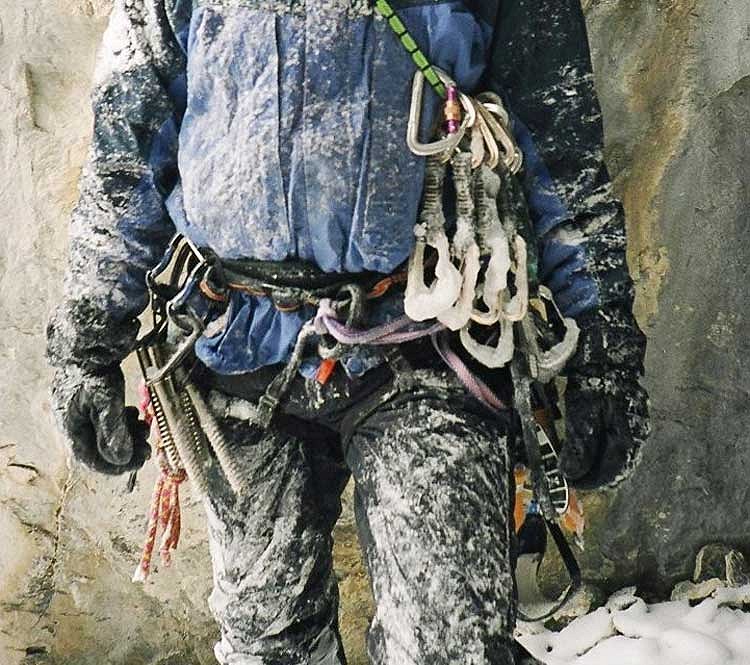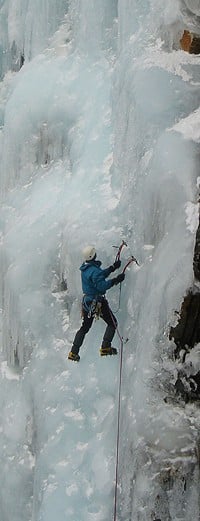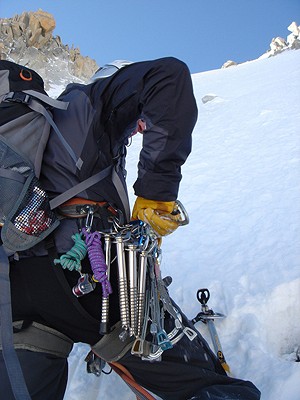

First have a look at your ice axes; make sure they're in good condition and check all the nuts and bolts. If you're changing the pick then sometimes it's a good idea to replace the nuts as some have nylon threads.


Sharpen your crampons with a fine file so that the teeth are sharp and will bite into hard waterfall ice. Check that they fit your winter boots well and that any nuts and bolts are tight. Also check that the crampon straps are in good order and with no frayed ends. Nothing worse than trying to thread a frozen frayed strap through two small eyelets with gloves on!
Read Graham Gedge's UKClimbing.com article, Sharpening up your act, and your ice tools HERE
Give your harness a good check over for bad wear marks and give some thought as to how you're going to rack the ice screws on to it. I use a combination of the Simond Rack for my right hand (which is the hand I place most of my screws with) and the plastic Black Diamond clipper with a lightweight wire gate for my left. These systems save you loads of time and energy when racking about 10-12 ice screws and work well. The systems also allow you to clip and unclip ice screws from your harness with either hand, while the other is still holding onto a secure axe placement. Just remember to have a system on both sides of your harness as you can't always predict where the best ice will be and with which hand you'll need to place the ice screw. You could also make your own system by taping a large bent gate karabiner facing downwards to your harness. Clip it through your harness waist band first, tape it so that it doesn't move and then the screws will rack in the end where the gate opens. The ice screw hanger pushes against the gate of the karabiner, opening it and allowing you to hook the screw onto the karabiner with one gloved hand.
The boots you normally use for winter should be given a good airing and the laces changed if necessary. Also give some thought to your clothing and choose a layering system that will not only keep you warm but also allow you plenty of movement. Gloves are very important in winter and two pairs of thick finger gloves are best. Wear one pair and carry the other, so that when one pair gets cold and wet you can change them and your hands will keep continually warm. Keep the thick pairs for climbing and wear a thin fleece pair on the walk in, as if you do sweat in the thick ones you will have cold hands from the word go.
Always carry a small headlamp in your rucksack as the days are shorter in winter, also plenty of food which you can carry in a handy pocket and eat on the belays. Take a fleece hat that fits comfortably under your helmet and carry a pair of sunglasses, as generally the best ice in cold temperatures will be found in the sun.
The main thing with ice climbing kit is to know how it works and to have it carefully sorted out before you climb, as the more organised you are with your leashes, racking your ice screws etc. the easier, less pumped, warmer, and safer your climbing will be. Now with all my own kit sorted I'm even more excited about the coming winter and looking forward to some great Alpine icefalls!

ISM (the International School of Mountaineering Limited) have been running the most extensive programme of alpine mountaineering courses since 1965. This is coupled with a range of 'Haute Route' treks across the Alps in summer, with Ski Tours and Off-piste skiing courses throughout the spring, and with ice climbing courses in the winter months. Countless people have discovered the mountains through ISM; experienced climbers return time after time to enjoy and progress through our wide-ranging alpine programme and perhaps share the great adventure of an ISM expedition. For more details visit our website at the International School For Mountaineering
Adrian Nelhams

He lives in the Lake District with his family.






Comments